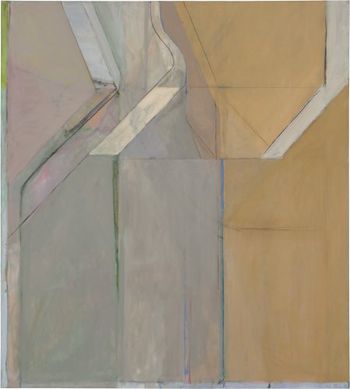|
KYSO Flash ™
Knock-Your-Socks-Off Art and Literature
|
|
|||
Richard Diebenkorn’s Ocean Park #17 (1968)by Charles D. Tarlton
The artist stands ready in the presence of a blank canvas, but nothing so far has happened. Up ahead in time a finished painting is waiting, but something has to take place now to launch the creative act. The painter has a long straight edge and a piece of charcoal; he draws three parallel horizontal lines, and then, fidgeting with the straight edge, lays in three more parallel lines diagonally. The canvas has been “besmirched,” and the artist has his problem.
these are not pictures
from the toothings Here is a definition of process. Building on the stimulus of the first lines he drew on the canvas, the painter improvises colored shapes as needed, drawing other lines, following the promptings of whatever just emerged, gesture, then color, then another gesture, until he is exhausted. But, wait, the next morning, back in the studio, he repents, and begins to scratch out and paint over yesterday’s markings, leaving hints to reveal here and there the way he had come.
he only knew it was
any truth in the art You cannot ask what any of it means or represents, more than his efforts to get right the thing that had kept going. The peculiar angular drawings in the top half of the picture just happened in the working out of pressures from the day before. They are pictures of nothing, lines arranged to the emotional satisfaction of the artist. Still, they are interesting, are they not?
what do you think
what’s wonderful All the Ocean Parks started in the same manner, though this is not something one can say in a strictly historically way. No one was there watching, but the familiar diagonals appear in nearly every painting (are they hiding in every one?) cutting across the horizontal-vertical matrix. And in nearly every painting they have been worked back into the deep pentimenti by over-painting and erasure, never completely obliterated because they constituted the glimpse from which the works arose. Not perfect evidence, perhaps, but enough to help us understand the genesis of the archetypal motif.
but still its details
no two days alike Art Criticism 101B
what if he had
we might then indeed
Author’s Note:
No. 17 is a brilliant example of Richard Diebenkorn’s now legendary exploration of architecture and light in his “Ocean Park” series. The Ocean Park works are essentially conversations between “ocean”—broad areas of atmospheric color implying nature’s vastness—and “park”—ambiguous lines evoking a desire for order and containment.2 However, “Ocean Park” refers neither to the ocean nor to a park, but to an area near the beach in Santa Monica, California, north and south of Ocean Park Boulevard. This is where Diebenkorn had a studio. Architecture? The idea must arise from all the straight lines. Light? All the bright colors, yellow and white, why, they must be representative of—light. Ocean? I don’t know. You tell me. And park? You mean park like grass and trees and, oh, aren’t those the legs of giant picnic tables?
Publisher’s Notes:
—From Tarlton’s full-length collection, Touching Fire: New and Selected Ekphrastic Prosimetra (KYSO Flash Press, December 2018); appears here with his permission |
|
Site contains text, proprietary computer code, |
|
| ⚡ Many thanks for taking time to report broken links to: KYSOWebmaster [at] gmail [dot] com ⚡ | |
